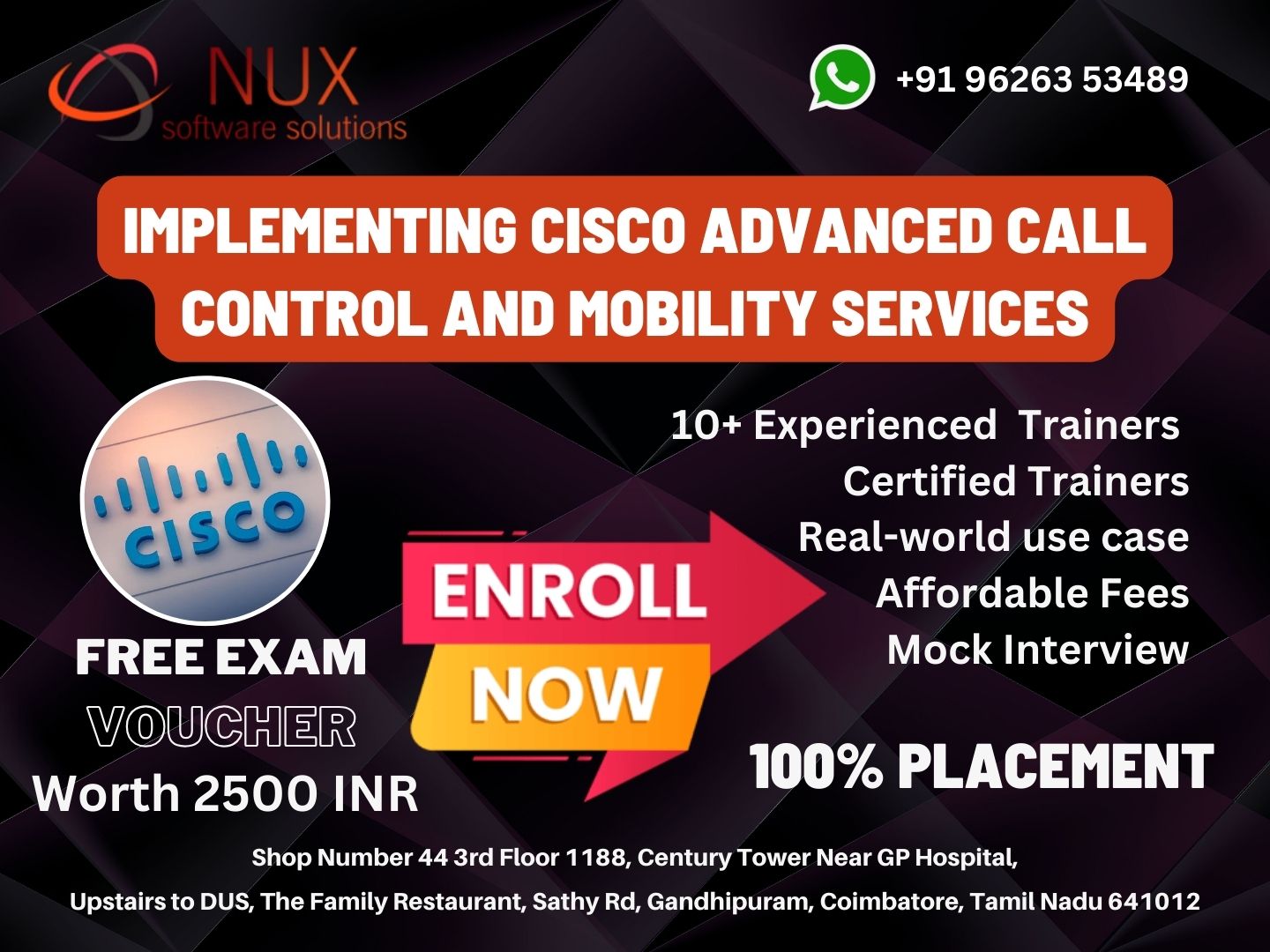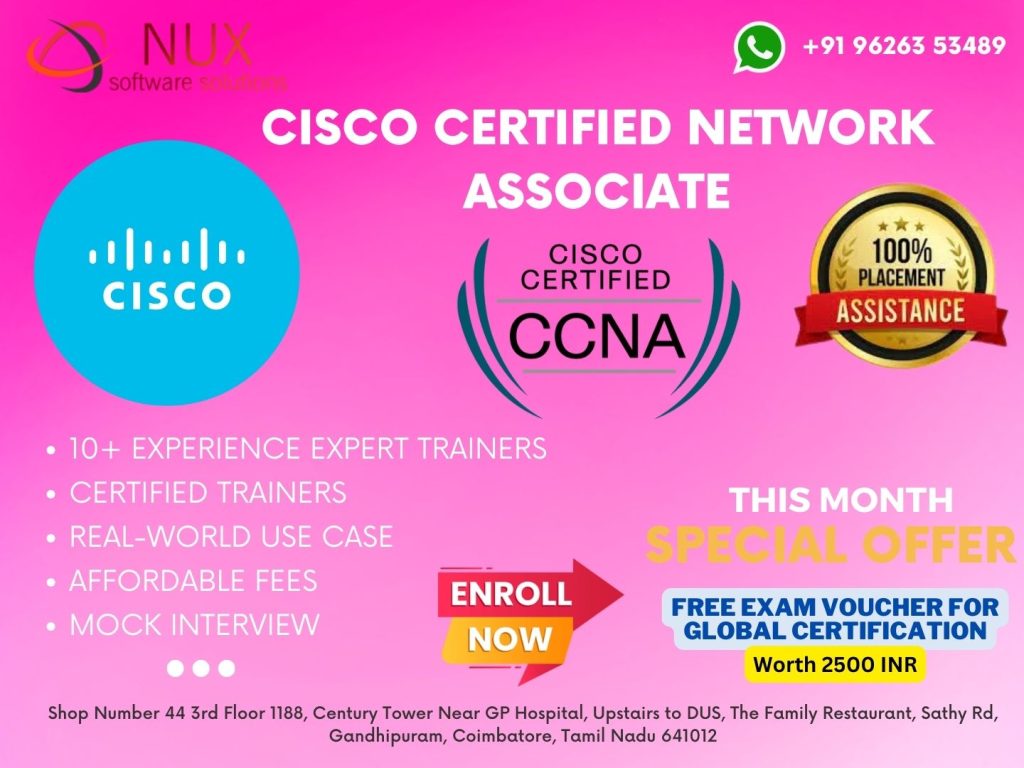Implementing Cisco Advanced Call Control and Mobility Services 300-815

Implementing Cisco Advanced Call Control and Mobility Services (300-815 CLACCM) Training in Coimbatore
Course Overview
The Cisco 300-815 CLACCM exam, also known as Implementing Cisco Advanced Call Control and Mobility Services, is a concentration exam for the CCNP Collaboration certification. This course is designed for professionals who want to deepen their understanding of advanced call control and mobility features in Cisco Unified Communications Manager (CUCM) and related platforms.
At Linux Training Center in Coimbatore, our 300-815 CLACCM training provides in-depth, hands-on experience in configuring and troubleshooting call control features and mobility services. This course prepares candidates to manage complex voice environments and successfully pass the CLACCM certification exam.
Why Choose 300-815 CLACCM?
This certification validates your ability to implement and troubleshoot advanced call routing, call control, and mobility features across Cisco’s collaboration infrastructure. If you are pursuing a CCNP Collaboration path or managing enterprise-level voice networks, this training gives you the skills needed to support real-world voice deployments.
Earning this credential proves your expertise in topics such as CUCM call routing logic, call admission control, inter-site dialing, and Device Mobility.
Who Should Enroll?
This course is ideal for:
Collaboration engineers and voice administrators
Network engineers managing CUCM deployments
IT professionals pursuing CCNP Collaboration certification
VoIP engineers and telecom professionals
UC support engineers and system integrators
Prerequisites include a good understanding of basic CUCM configuration and IP telephony concepts.
What You Will Learn
Advanced call routing configuration in Cisco Unified Communications Manager
Route patterns, translation patterns, and digit manipulation
Globalized call routing and URI dialing
Cisco Unified Border Element (CUBE) call control integration
Call admission control (CAC), Locations, and Regions
Device Mobility and Extension Mobility
Inter-cluster and intra-cluster call signaling
Survivable Remote Site Telephony (SRST) configuration
Troubleshooting tools for call routing and mobility issues
Our course aligns directly with the topics covered in the official Cisco 300-815 exam blueprint and includes real-world lab simulations.
Course Highlights
Expert-led training by certified Cisco collaboration engineers
Hands-on labs using Cisco CUCM, CUBE, and related tools
Comprehensive courseware covering all exam objectives
Real-time troubleshooting experience in lab environments
Exam preparation tips, mock assessments, and guidance
Flexible learning formats – online, weekday, and weekend batches
Career Opportunities
After completing the 300-815 CLACCM certification, professionals can move into roles such as Collaboration Engineer, VoIP Engineer, Unified Communications Specialist, Senior Network Engineer, or Telecom Engineer. This course also serves as a core part of earning your CCNP Collaboration credential.
Why Linux Training Center?
Linux Training Center in Coimbatore delivers industry-ready training with a focus on practical labs, real-time use cases, and expert instruction. Our Cisco collaboration track is designed to help you build the technical depth required for advanced roles in enterprise communication systems.
300-815: Implementing Cisco Advanced Call Control and Mobility Services Syllabus
1.0 Signaling and Media Protocols
1.1 Troubleshoot these elements of a SIP conversation
- 1.1.a Early media
- 1.1.b PRACK
- 1.1.c Mid-call signaling (hold/resume, call transfer, conferencing)
- 1.1.d Session timers
- 1.1.e UPDATE
1.2 Troubleshoot these H.323 protocol elements
- 1.2.a DTMF
- 1.2.b Call set up and tear down
1.3 Troubleshoot media establishment
2.0 CME/SRST Gateway Technologies
2.1 Configure Cisco Unified Communications Manager Express for SIP phone registration
2.2 Configure Cisco Unified CME dial plans
2.3 Implement toll fraud prevention
2.4 Configure these advanced Cisco Unified CME features
- 2.4.a Hunt groups
- 2.4.b Call park
- 2.4.c Paging
2.5 Configure SIP SRST gateway
3.0 Cisco Unified Border Element
3.1 Configure these Cisco Unified Border Element dial plan elements
- 3.1.a DTMF
- 3.1.b Voice translation rules and profiles
- 3.1.c Codec preference list
- 3.1.d Dial peers
- 3.1.e Header and SDP manipulation with SIP profiles
- 3.1.f Signaling and media bindings
3.2 Troubleshoot these Cisco Unified Border Element dial plan elements
- 3.2.a DTMF
- 3.2.b Voice translation rules and profiles
- 3.2.c Codec preference list
- 3.2.d Dial peers
- 3.2.e Header and SDP manipulation with SIP profiles
- 3.2.f Signaling and media bindings
4.0 Call Control and Dial Planning
4.1 Configure these globalized call routing elements in Cisco Unified Communications Manager
- 4.1.a Translation patterns
- 4.1.b Route patterns
- 4.1.c SIP route patterns
- 4.1.d Transformation patterns
- 4.1.e Standard local route group
- 4.1.f TEHO
- 4.1.g SIP trunking
4.2 Troubleshoot these globalized call routing elements in Cisco Unified Communications Manager
- 4.2.a Translation patterns
- 4.2.b Route patterns
- 4.2.c SIP route patterns
- 4.2.d Transformation patterns
- 4.2.e Standard local route group
- 4.2.f TEHO
- 4.2.g SIP trunking
5.0 Cisco Unified CM Call Control Features
5.1 Troubleshoot Call Admission Control (exclude RSVP)
5.2 Configure ILS, URI synchronization, and GDPR
5.3 Configure hunt groups
5.4 Configure call queuing
5.5 Configure time of day routing
5.6 Configure supplementary functions
- 5.6.a Call park
- 5.6.b Meet-me
- 5.6.c Call pick-up
6.0 Mobility
6.1 Configure Cisco Unified Communications Manager Mobility
- 6.1.a Unified Mobility
- 6.1.b Extension Mobility
- 6.1.c Device Mobility
6.2 Troubleshoot Cisco Unified Communications Manager Mobility
- 6.2.a Unified Mobility
- 6.2.b Extension Mobility
- 6.2.c Device Mobility



